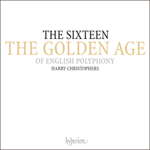
Welcome to Hyperion Records, a British classical label devoted to presenting high-quality recordings of music of all styles and from all periods from the twelfth century to the twenty-first.
Hyperion offers both CDs, and downloads in a number of formats. The site is also available in several languages.
Please use the dropdown buttons to set your preferred options, or use the checkbox to accept the defaults.

O splendor gloriae is in many ways the finest of Taverner’s large-scale antiphons. Particularly noteworthy are its clarity of texture and extensive use of imitation. So pervasive and systematic is the imitation in some passages that it led one late sixteenth-century copyist to ascribe the work jointly to Taverner and Tye, a view rejected by modern scholars on the grounds of its stylistic consistency. Another ‘progressive’ feature is the occasional repetition of text in the latter part of the piece, reflecting the gradual trend away from an abstract melismatic style towards a more directly expressive ‘Renaissance’ manner. The sectional structure, contrasting reduced ‘soloistic’ combinations with full five-part sections which exploit the high treble compass, is characteristically English in conception, and the work stands as testimony to the vocal and musical accomplishments of pre-reformation choral foundations.
from notes by John Heighway © 2000
O splendor gloriae est à de nombreux égards, la plus belle des antiennes à grande échelle de Taverner. La clarté de sa texture et le grand emploi de l’imitation sont particulièrement remarquables. L’imitation y est en effet si généralisée et si systématique dans certains passages qu’un copiste de la fin du seizième siècle attribua l’œuvre à Taverner et à Tye, une opinion réfutée par les spécialistes modernes sur la base de l’uniformité stylistique. Un autre trait «progressiste» est la répétition occasionnelle du texte dans la dernière partie du morceau, un reflet de la tendance graduelle à s’éloigner d’un style abstrait mélodieux orné pour aller vers une manière «renaissance» plus directement expressive. La structure des sections, des combinaisons «solistes» réduites contrastant avec des sections complètes à cinq parties qui exploitent toute la gamme soprano alto, est de conception typiquement anglaise et l’œuvre est un témoignage des réalisations vocales et musicales des fondations chorales avant la Réforme.
extrait des notes rédigées par John Heighway © 2000
Français: Martine Erussard
O splendor gloriae ist in vieler Hinsicht die schönste von Taverners grösseren Antiphonen. Besonders hervorhebenswert sind die Klarheit der Struktur und die ausgiebige Anwendung der Imitation. So durchdringend und systematisch ist die Imitation in einigen Passagen, dass ein Kopist des späten 16. Jahrhunderts sich dazu hinreissen liess, das Werk gemeinsam Taverner und Tye zuzuschreiben. Dies wird jedoch von modernen Gelehrten abgelehnt, da das Werk in seinem Stil völlig mit dem Schaffen Taverners in Einklang ist. Ein anderes „progressives“ Stilmerkmal ist die gelegentliche Wiederholung des Textes im letzteren Teil des Stückes, in der sich der allmähliche Trend von einem abstrakten, melismatischen Stil weg und zu einem unmittelbar ausdrucksvolleren „Renaissance-Stil“ hin kundgibt.
Der satzweise Aufbau, in dem reduzierte „solistische“ Kombinationen mit der vollen, den Diskant ausschöpfenden Fünfstimmigkeit kontrastieren, ist in seiner Konzeption typisch englisch. Das Werk lägt Zeugnis ab über die vokalen und musischen Errungenschaften vorreformatorischer Chorstiftungen.
aus dem Begleittext von John Heighway © 2000
Deutsch: Eike Hibbett
 The Sixteen & The Golden Age of English Polyphony The Sixteen & The Golden Age of English PolyphonyWhen The Sixteen embarked upon their recording career back in 1982, few would have been able to predict quite how far they would go towards rehabilitating the little-known music of these four master composers of the 16th century. In this their 30t ...» More |

